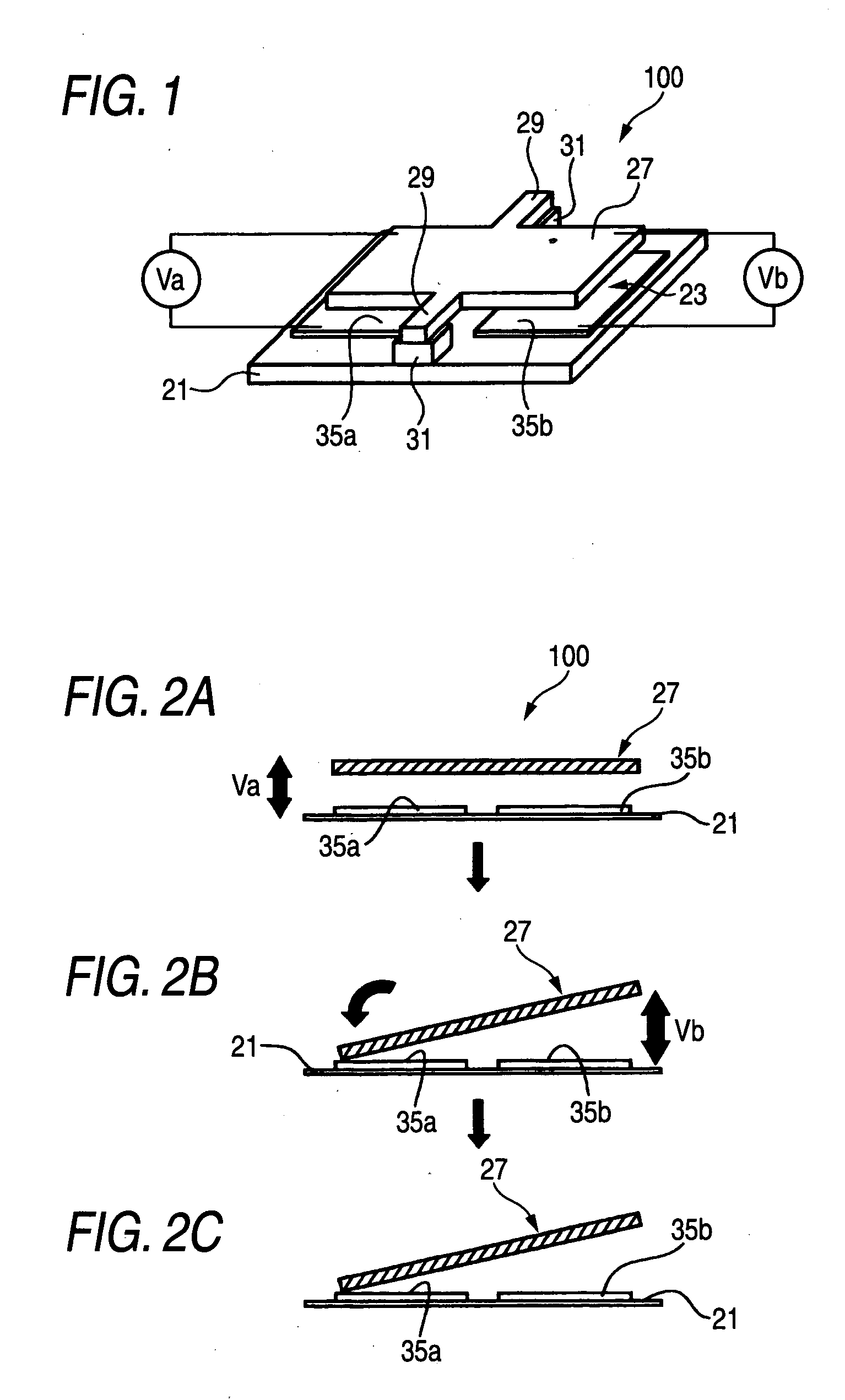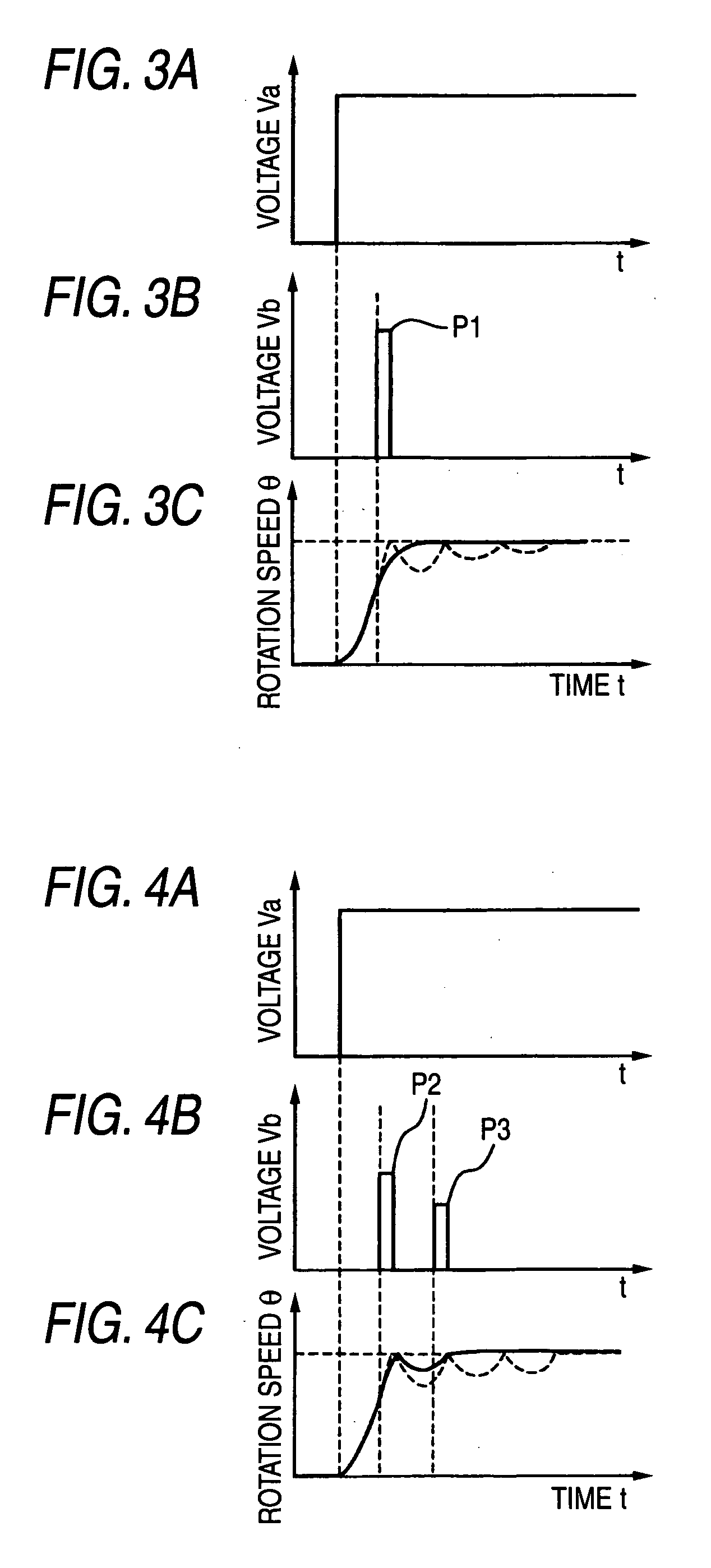Microelectromechanical modulation device and microelectromechanical modulation device array, and image forming apparatus
a microelectromechanical and modulation device technology, applied in the direction of optics, instruments, optical elements, etc., can solve the problems of affecting the speed of switching operation, and taking time to stop the oscillation, so as to reduce the driving cycle, active reduction of the oscillation of the movable portion, and the effect of reducing the time of anon/o
- Summary
- Abstract
- Description
- Claims
- Application Information
AI Technical Summary
Benefits of technology
Problems solved by technology
Method used
Image
Examples
first embodiment
[0087]FIG. 1 is a conceptual view illustrating a microelectromechanical modulation device according to the invention. FIGS. 2A to 2C are operation explanatory views illustrating a damping process of the microelectromechanical modulation device shown in FIG. 1. FIGS. 3A to 3C are explanatory views illustrating a behavior of a movable portion to which a pulse waveform is applied.
[0088] The microelectromechanical modulation device (hereunder also referred to simply as a “modulation device”) 100 according to this embodiment includes a substrate 21, a small-piece-like movable portion disposed in parallel to the substrate 21 through a gap 23, hinges 29, 29 respectively extended from both edge parts of the movable portion 27, and spacers 31, 31 supporting the movable portion 27 on the substrate 21 through these hinges 29, 29, as fundamental components. By this configuration, the movable part is capable of being rotated and transited by the distortion of the hinges 29, 29.
[0089] When the m...
second embodiment
[0139] Next, the microelectromechanical device according to the invention is described hereinbelow.
[0140]FIG. 14 is a conceptual view illustrating the second embodiment of the microelectromechanical modulation device according to the invention.
[0141] A modulation device 200 according to this embodiment is configured so that two or more physical action forces can be set corresponding to the direction of transition of the movable portion 27. That is, a set of a main first address electrode 35a1, and an auxiliary first address electrode 35a2, and another set of a main second address electrode 35a1 and an auxiliary second address electrode 35b2 are provided on both sides of the hinges 29, 29 on the central part of the top surface of the substrate 21. A driving voltage Val is applied between the main first address electrode 35a1 and the movable portion 27, while a driving voltage Va2 is applied between the auxiliary first address electrode 35a2 and the movable portion 27. Further, an os...
third embodiment
[0144] Next, the microelectromechanical device according to the invention is described hereinbelow.
[0145]FIG. 15 is a conceptual view illustrating a third embodiment of the microelectromechanical modulation device according to the invention.
[0146] A modulation device 300 according to this embodiment is configured so that one of ends of a movable portion 41 is supported by and is fixed to the substrate 21 through the hinges 29, 29 and spacers 31, 31. That is, the movable portion 41 is configured like a cantilever, so that the other end of the movable portion 41 is a free end. Further, a first address electrode 35a facing the free end of the movable portion 41 is provided on the substrate 21. A second address electrode 35b to be formed on an opposed substrate (not shown) is provided on the side opposite to the first address electrode 35a so that the movable portion 41 is sandwiched between the first address electrode 35a and the second address electrode 35b.
[0147] Even in the modula...
PUM
 Login to View More
Login to View More Abstract
Description
Claims
Application Information
 Login to View More
Login to View More - R&D
- Intellectual Property
- Life Sciences
- Materials
- Tech Scout
- Unparalleled Data Quality
- Higher Quality Content
- 60% Fewer Hallucinations
Browse by: Latest US Patents, China's latest patents, Technical Efficacy Thesaurus, Application Domain, Technology Topic, Popular Technical Reports.
© 2025 PatSnap. All rights reserved.Legal|Privacy policy|Modern Slavery Act Transparency Statement|Sitemap|About US| Contact US: help@patsnap.com



